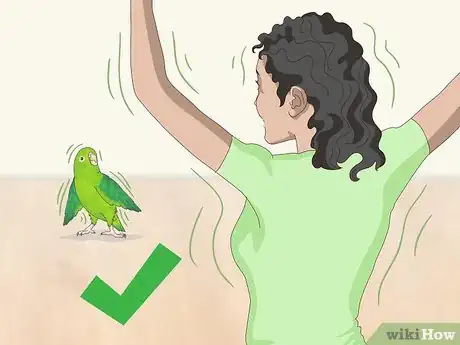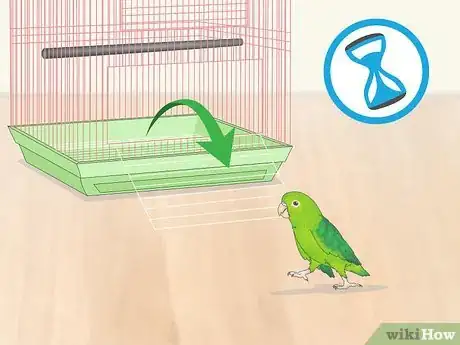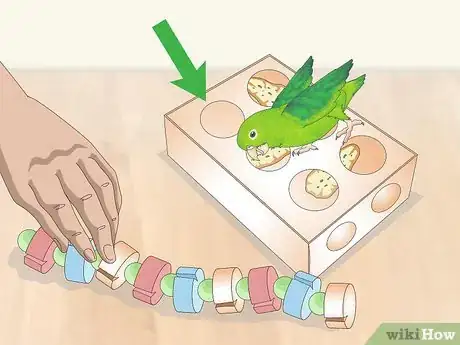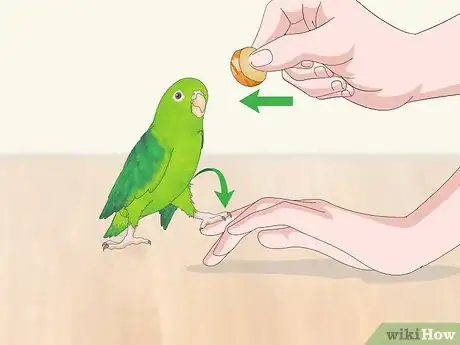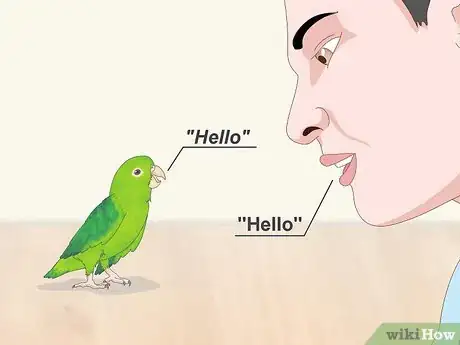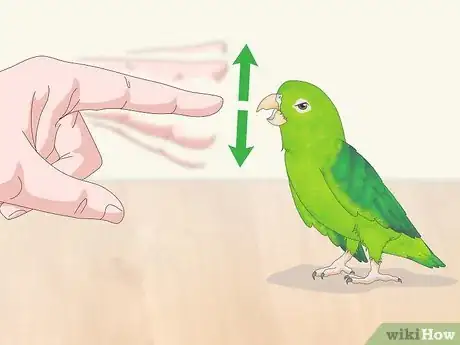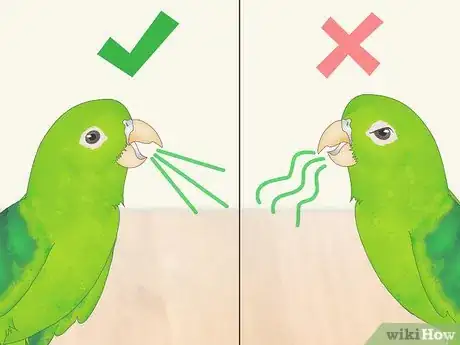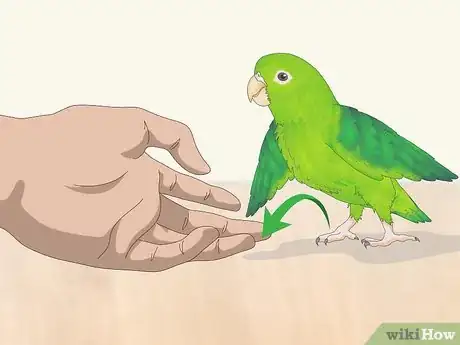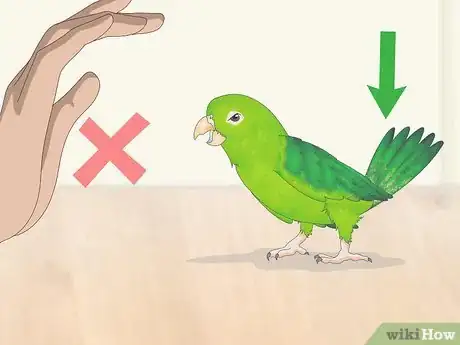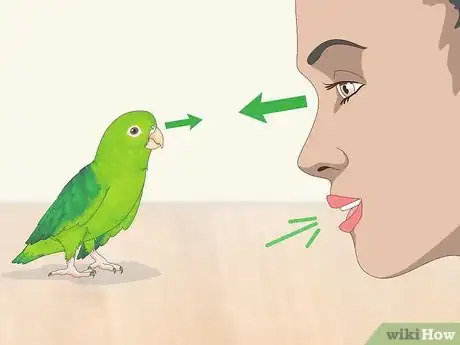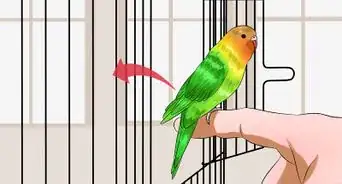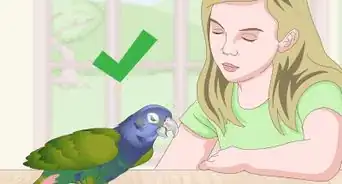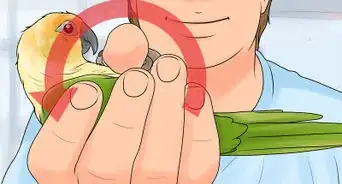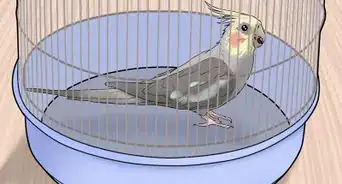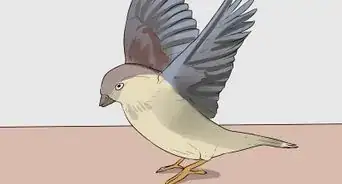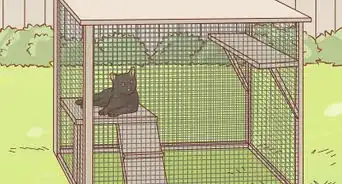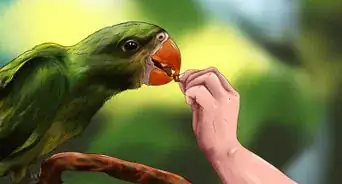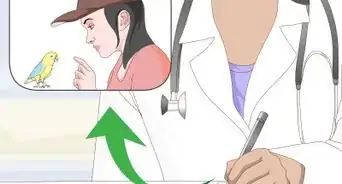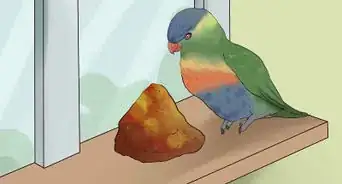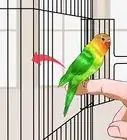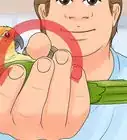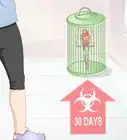This article was co-authored by Deanne Pawlisch, CVT, MA. Deanne Pawlisch is a Certified Veterinary Technician, who does corporate training for veterinary practices and has taught at the NAVTA-approved Veterinary Assistant Program at the Harper College in Illinois and in 2011 was elected to the board of the Veterinary Emergency and Critical Care Foundation. Deanne has been a Board Member of the Veterinary Emergency and Critical Care Foundation in San Antonio, Texas since 2011. She holds a BS in Anthropology from Loyola University and an MA in Anthropology from Northern Illinois University.
There are 12 references cited in this article, which can be found at the bottom of the page.
This article has been viewed 28,031 times.
Parrotlets are intelligent, feisty birds that love to interact with their owners. Since its small body is fragile, handle your bird gently and only when it’s calm. Spend lots of quality time with your pet every day to make sure it gets the social interaction it needs. Training your bird will give it mental stimulation, and a variety of toys will enrich playtime and keep it busy while you’re away from home. Get to know your bird’s body language and vocalization so you can communicate clearly with your feathered friend.
Steps
Playing with Your Pet
-
1Handle your parrotlet gently. Since they’re built for flight, birds are fragile animals and must be handled with care. Use one swift motion if you need to remove your parrotlet from its cage, and keep a firm grip without holding it too tightly. Place one hand’s thumb and index finger on the back and side of its head and the other hand around its body to gently restrain it.[1]
- Do not squeeze the bird’s chest or he will not be able to breathe.
- Avoid grasping a bird by its wing, leg, or tail. Do not hold the bird around his chest either. For best results, handle your bird when it’s calm.
- Work on training your bird to step up to minimize stress during handling.
-
2Spend quality time together every day. Talk, dance, train, and play with your bird every day. Parrotlets are high energy and need daily social interaction. While it can keep itself busy playing with toys inside its enclosure, it will need to bond and spend lots of quality time with its owner.[2]Advertisement
-
3Give your parrotlet ample out of cage time. Since they’re so feisty, daily out of cage time will help your bird burn off energy and prevent bad behavior. Let your bird out into an enclosed room, and be sure to keep it under close supervision.[3]
- Try hiding treats on the bird’s play stand. Foraging is a stimulating activity that will help keep your bird happy.
-
4Provide your bird with a steady rotation of toys. A variety of toys will help enrich playtime and keep your bird entertained when you’re away from home. Go for puzzle toys, food dispensing toys, chew toys, and those with contrasting colors and textures.[4]
- Since their beaks are strong for their size, choose durable toys, such as those marked for cockatiels and conures. Typically, toys marked for finches and budgies aren’t strong enough for parrotlets.[5]
Training Your Bird
-
1Teach your parrotlet step up and step down commands. Offer a favorite treat just above and in front of your parrotlet’s head, and hold your finger just above its feet. Say “Step up,” and encourage your bird to hop onto your finger. If it just stretches up to reach for the treat, give it the treat and praise it, then try again until it steps onto your finger.[6]
- If your parrotlet has a biting problem, use a handheld perch instead of your finger. If it bites you when it is on your finger, bob your finger up and down slightly to deter him. He will have a harder time biting if his perch is moving.
-
2Towel train your parrotlet. Hold your bird in a small towel or washcloth, and give it treats so it forms a positive association with the towel. Gently roll it up in the towel as if you were swaddling a baby, and make sure you contain its wings and legs without holding it too tightly.[7]
- Holding it in a towel can come in handy when grooming your bird, such as trimming its nails or wings.[8]
-
3Teach your parrotlet to speak. Parrotlets are capable of memorizing a handful of words, and teaching your bird to speak can be fun for you and your pet. Start with simple words, like “hello,” “bird,” or your pet’s name. Have patience, speak slowly and clearly, and give heaps of enthusiastic praise if your parrotlet says its first word.[9]
-
4Use positive reinforcement training to correct undesirable behaviors. Nipping, lunging, and other aggressive behaviors are common in parrotlets. Other than gently bobbing your finger up and down to deter biting, ignore your parrotlet when it misbehaves. Give it a toy to bite if it starts to act up, and offer treats and praise when it plays without acting aggressively.[10]
- If your parrotlet is acting up, you might need to enrich its environment to keep it busy. Make sure it has toys, a variety of perches (natural branches and swing perches are great), and hide treats throughout its enclosure to encourage foraging.[11]
- You may also consider using a clicker to reinforce positive behavior. You can purchase a clicker in most pet stores. Click the clicker every time your parrotlet does something good to mark the behavior and then reward him right away. Parrotlets respond well to clicker training.
-
5Keep your parrotlet’s wings trimmed. Your parrotlet will be more receptive to training if you keep his wings trimmed. If you have never trimmed your parrotlet’s wings before, then take him to the veterinarian and ask for a demonstration. This will help to ensure that you are trimming your parrotlet’s wings the right way.
Communicating with Your Parrotlet
-
1Learn what your parrotlet’s vocalizations mean. High pitched twitters and whistling are signs of a happy parrotlet. Growling is a sign of agitation, so check its environment for anything upsetting that you might want to remove. Avoid handling your bird when it’s growling.[12]
-
2Recognize playful body language. Leaning forward with its wings half raised and feathers fluffed means your bird wants to be picked up. Hanging from the cage with its beak or feet means it wants to play. Placing its beak on the ground with its head and neck feathers fluffed means it wants a scratch.[13]
- Observe your bird to get it to know its particular ways of expressing itself through body language.
-
3Look for signs that your bird is agitated. Pinned, staring eyes can mean your bird is fascinated or agitated, so try to look for other body language cues or stressors in its environment. If you’re handling it and it waves its feet around in the air, it wants to be put down. While a tail shake is usually playful, tail fanning is a sign that your bird is feeling agitated or aggressive.[14]
- Lunging or biting are also signs of aggression, and might indicate it doesn’t like how you’re handling it.
-
4Make eye contact and speak to your parrotlet clearly. Parrotlets are intelligent animals and can learn objects’ names and to follow commands. Keep steady eye contact when you communicate with your pet so it knows to focus on you. Speak slowly and clearly, as if you were speaking to a small child, and use consistent words and tone of voice when labeling objects and behaviors.[15]
References
- ↑ http://www.avianwelfare.org/shelters/pdf/NBD_shelters_parrots.pdf
- ↑ http://www.peteducation.com/article.cfm?c=15+1840&aid=2332
- ↑ https://www.beautyofbirds.com/parrotletsinfo.htm
- ↑ https://www.beautyofbirds.com/parrotletsinfo.htm
- ↑ https://www.animalhumanesociety.org/adoption/parrotlet-care
- ↑ https://www.beautyofbirds.com/steppingup.html
- ↑ http://www.avianwelfare.org/shelters/pdf/NBD_shelters_parrots.pdf
- ↑ https://www.thespruce.com/how-to-hold-a-bird-safely-390778
- ↑ https://www.beautyofbirds.com/talking.html
- ↑ https://www.beautyofbirds.com/breakingparrots.html
- ↑ https://www.beautyofbirds.com/redirectingnegativebehavior.html
- ↑ http://www.peteducation.com/article.cfm?c=15+1795&aid=3334
- ↑ https://www.beautyofbirds.com/communicatewithyourbirds.html
- ↑ https://www.beautyofbirds.com/biting.html
- ↑ https://www.beautyofbirds.com/communicatewithyourbirds.html
About This Article
When you interact with your parrotlet, handle it very gently, and be careful not to squeeze it so tightly that it can’t breathe easily. Parrotlets have lots of energy and need daily social interaction, so spend time with it every day. Have some fun talking, dancing, and playing with your parrotlet, and let it out of its cage to burn off some energy with close supervision. To keep your bird mentally stimulated, give it a variety of toys to play with when you’re not home. Go for puzzle toys, food dispensing toys, chew toys, and toys with bright colors and varied textures to keep your bird entertained. For more tips from our Veterinary co-author, like how to train your parrotlet to speak, keep reading!

